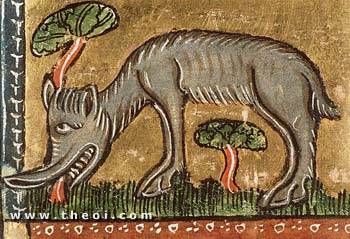
August 27, 2010
From the file of “Classic Animals of Discovery”…

Catoblepas, Der Naturen Bloeme manuscript
c. 1350, National Library of the Netherlands
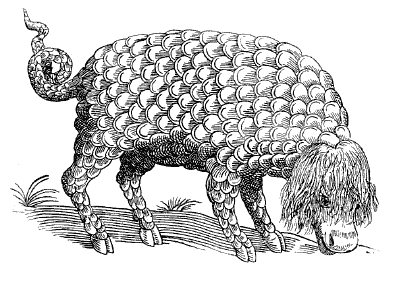
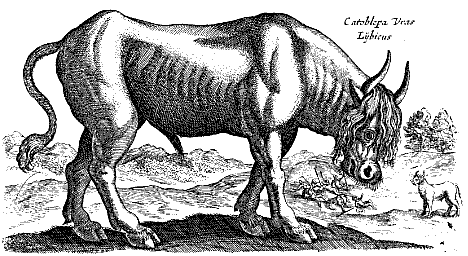
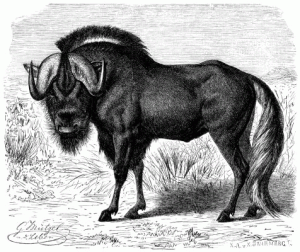
Pliny- “In Western Aethiopia [West Africa] there is a spring, the Nigris, which most people have supposed to be the source of the Nile . . . In its neighbourhood there is an animal called the Catoblepas, in other respects of moderate size and inactive with the rest of its limbs, only with a very heavy head which it carries with difficulty and it always hanging down to the ground. Otherwise it is deadly to humans, as all who see its eyes expire immediately.” (Natural History, C1st A.D.)
Aelian -“Libya [Africa] is the parent of a great number and a great variety of wild animals, and moreover it seems that the same country produces the animal called the Katoblepon (Down-Looking). In appearance it is about he size of a bull, but it has a more grim expression, for its eyebrows are high and shaggy, and they eyes beneath are not large like those of oxen but narrower and bloodshot. And they do not look straight ahead but down on to the ground: that is why it is called ‘down-looking’. And a mane that begins on the crown of its head and resembles horsehair, falls over its forehead covering its face, which makes it more terrifying when one meets it. And it feeds upon poisonous roots. When it glares like a bull it immediately shudders and raises its mane, and when this has risen erect and the lips about its mouth are bared, it emits from its throat pungent and foul-smelling breath, so that the whole air overhead is infected, and any animals that approach and inhale it are grievously afflicted, lose their voice, and are seized with fatal convulsions. This beast is conscious of its power; and other animals know it too and flee from it as far away as they can.” (On Animals, C2nd A.D.)
Topsell- “Pliny calleth this beast Catablepon, because it continually looketh downwards, and saith all the parts of it are but smal excepting the head, which is very heavy, and exceedeth the proportion of his body, which is never lifted up, but all living creatures die that see his eies. By which there ariseth a question whether the poison which he sendeth foorth, proceede from his breath, or from his eyes. Whereupon it is more plausible, that like the cockatrice, he killeth by seeing, than by the breath of his mouth, which is not competible to any other beasts in the world.” (The Historie of Foure-Footed Beastes)
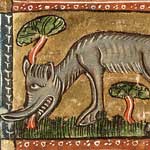
Catoblepas. Semimythical mammal of North Africa.
Etymology: Greek, “that which looks downward.”
Variant names: Catoplepe, Gorgon.
Physical description: Body like a bull. Oversized head so heavy that it always hangs close to the ground. Bristled, scraggly head-hair from crown to nose. Scaly back. Small wings, according to later sources.
Behavior: Sluggish. Has an overpowering breath (odor). Its gaze can kill (though Pliny may have gotten this characteristic mixed up with the Basilisk).
Distribution: The Nile River in Egypt, east to Ethiopia.
Possible explanation: The Black wildebeest or White-tailed gnu (Connochaetes gnou) is a stocky, dark-brown antelope with front-facing horns and a strange tuft of long hair on the muzzle that acts as a scent-dispenser for its face glands. It is found in South Africa. Its fighting posture is to kneel on the ground and hook its opponent from below with its sharply angled horns. The related Blue wildebeest or Brindled gnu (C. taurinus), of South and East Africa, ranged much father north where Pliny was more likely to have heard about it, possibly persisting on the North African coast into historic times.
Sources: Pliny the Elder, Natural History, viii. 32; Ælian, De natura animalium, viii. 105; Edward Topsell, The Historie of Foure-Footed Beastes (London: William Iaggard, 1607); Peter Costello, The Magic Zoo (New York: St. Martin’s, 1979), pp. 111–114.
The above is from George Eberhart’s excellent cryptozoology reference work, Mysterious Creatures .
What does the Catoblepas sound like to you?
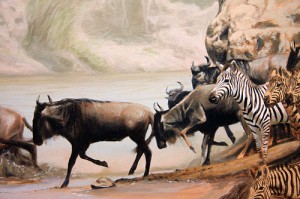
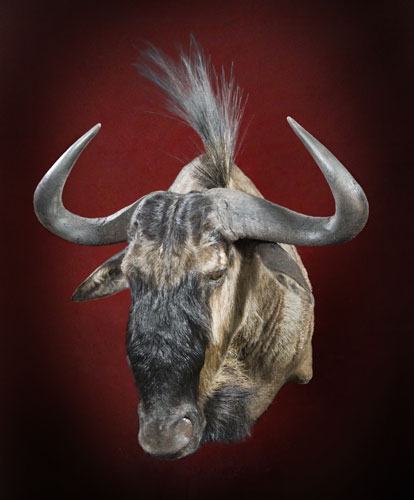
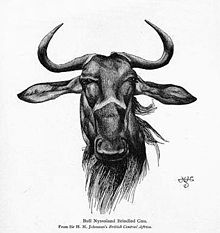
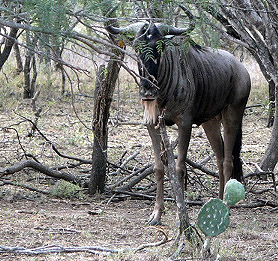
The wildebeest was eventually discovered and verified by zoology in 1777.
Black Wildebeest or White-tailed Gnu
Connochaetes gnou
(Zimmermann, 1780)
Gnou is a Hottentot name for these antelope. Crossword puzzle fans are well-aware of the wildebeest also being called the gnu.
Connochaetes
(Lichtenstein, 1812)
The Blue or Common Wildebeest
Connochaetes taurinus
(Burchell, 1823)
Subspecies:
C. t. albojubatus, Eastern White-bearded Wildebeest
C. t. cooksoni, Cookson’s Wildebeest
C. t. johnstoni, Nyassaland Wildebeest
C. t. mearnsi, Western White-bearded Wildebeest
C. t. taurinus, Blue Wildebeest or Bridled Gnu
About Loren Coleman
Loren Coleman is one of the world’s leading cryptozoologists, some say “the” leading living cryptozoologist. Certainly, he is acknowledged as the current living American researcher and writer who has most popularized cryptozoology in the late 20th and early 21st centuries.
Starting his fieldwork and investigations in 1960, after traveling and trekking extensively in pursuit of cryptozoological mysteries, Coleman began writing to share his experiences in 1969. An honorary member of Ivan T. Sanderson’s Society for the Investigation of the Unexplained in the 1970s, Coleman has been bestowed with similar honorary memberships of the North Idaho College Cryptozoology Club in 1983, and in subsequent years, that of the British Columbia Scientific Cryptozoology Club, CryptoSafari International, and other international organizations. He was also a Life Member and Benefactor of the International Society of Cryptozoology (now-defunct).
Loren Coleman’s daily blog, as a member of the Cryptomundo Team, served as an ongoing avenue of communication for the ever-growing body of cryptozoo news from 2005 through 2013. He returned as an infrequent contributor beginning Halloween week of 2015.
Coleman is the founder in 2003, and current director of the International Cryptozoology Museum in Portland, Maine.
Filed under Classic Animals of Discovery, Cryptomundo Exclusive, Cryptotourism, CryptoZoo News, Cryptozoology, Eyewitness Accounts, Folklore, Megafauna, Museums